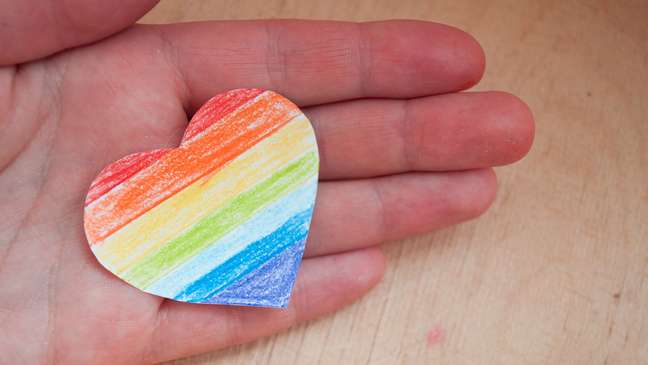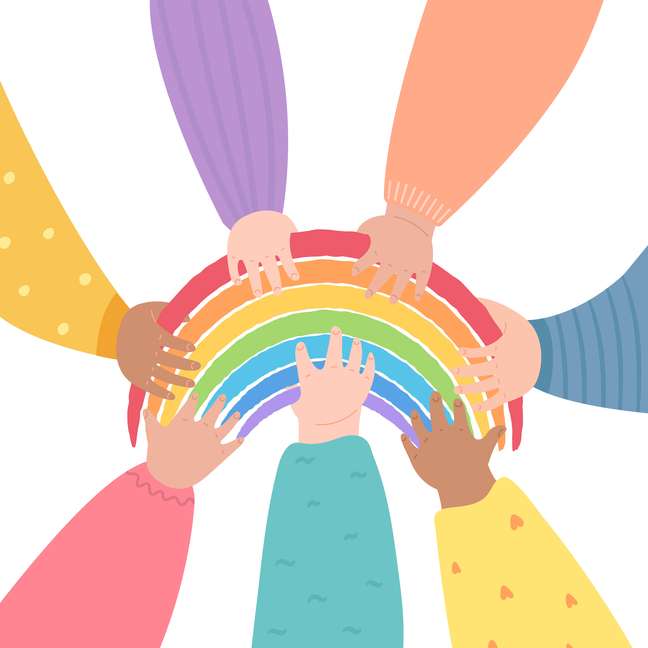Educating children that are open and without prejudice often requires parents to make an effort to understand and observe the world in all its plurality.
Just say you’re pregnant, and here comes the question: Do you know if it’s a boy or a girl? Everyone wants to find out about gender, sometimes to help determine the type of kit, clothes, toys. Most of the time we don’t stop to think about it, but at this moment, when the baby is not yet fully formed in the womb, we have already begun to put a series of gender expectations.

It is then that the family does not brew revealing tea, which is still on the rise, and it is an entire event centered around the discovery and specific revelation of this child’s characteristic: sex. All represented by blue and pink, blue for boys and pink for girls. It turns out that there are far more colors in the rainbow and it may be necessary to understand what is behind these idealizations to create more open and welcoming, less biased and generalist generations. For this to happen, the work begins with us adults. Fathers, mothers, uncles, grandparents, teachers …
“It is not possible to think about the role of parents that separates them from their culture, nor from their own stories. Therefore, it is necessary that each of us, parents and non-parents, revisit our own preconceptions related to sexuality “, explains psychologist Patricia Grinfeld, creator and founding partner of Não Cresce Sozinho, a mental health care platform focused on early childhood and parenthood. . “Prejudice arises from a closed concept, without openness to difference. In this sense, It is imperative that parents and all carers do not limit themselves to what they know, believe and assume. We need to go further and be minimally curious, interested in the other. It takes some work. Sometimes it frightens, because it implies coming into contact with the different, the unknown.“, points.
Nobody said it was going to be easy, did they?
All the colors of the rainbow
Boy thing and girl thing. Blue and pink. Cart and doll. Football and ballet. As the conversation has evolved, they are still very much present in society and culture. sexual stereotypes, which associate objects, colors, tastes and preferences to a genre. These issues have been discussed more, but there is still a long way to go in the sense of breaking these limiting beliefs. “What is at stake is the misconception that a certain color, type of clothing or toy defines what one is – and not that it is the result of a social construction,” says Patricia. ” We must remember that childhood is the moment of fiction, of the attempt to be what one is not. If we limit colors, clothes, toys and games, we limit the possibilities for experimentation and, therefore, the possibilities for the child to make choices, solve impasses, find creative outlets, which are important skills for life, both on an individual level. as in the collective“, he says.
These stereotypes, in addition to hindering children’s freedom in childhood and their training for the future, have nothing to do with subsequent sexual orientation. “The construction of adult sexuality depends on the set of experiences of the child. It’s not just childhood preferences that define sexual orientation.“, underlines the expert.
There is still a lot of confusion between biological sex (which corresponds to the physical characteristics that an individual has at birth, such as the type of genitals, chromosomes and hormonal composition), sexual orientation (which has to do with emotional, affective or sexual attraction to other people) and also gender (linked to social construction, i.e. to the set of roles, behaviors and functions that society expects from someone, based on sex). THE gender identity refers to the gender with which the person identifies, regardless of physical characteristics.
The world has evolved and these topics are being addressed more frequently, which is good news. “The topic is more in the media. People become more familiar with the speeches they find on television, in schools, etc. So they start to work better with gender diversity”, explains psychologist Kika Melhem, coordinator of the Generidades Outpatient Clinic. of the Institute of Psychology, Faculty of Psychology, University of São Paulo (AGE-IP – FP / USP). Even so, there is still a lot of prejudice and ignorance on the subject. We are far from being a society that accepts and welcomes differences. Reviewing our upbringing and prejudices, to teach, in addition to learning, children that there are different ways of being and loving – and that they are all equally valid – can be an interesting start.
ideal child vs real child
One of the main consequences of all this confusion caused by gender stereotypes is that many parents think there is a problem when the child wants to, for example, wear clothes of a color or pattern that are not intended for their biological sex, like a guy who wants to wear a skirt or dress. “This concern, in general, has to do with what parents expect of their children,” says psychologist Patricia. “Parents dream, they imagine a life for their children – and this is very important. When children present something other than what they imagine, many families do not know how to deal with the situation. The real child can exist as it is. Therefore, there is no other way there to address one’s concerns and the expectations and pressures of society other than through the way of being able to talk about them, deconstruct and rebuild expectations about children and about being a mother or father, “she stresses.

When does the child begin to perceive sexuality?
Children begin to notice that there are differences between the ages of 3 and 5, according to Patricia. “When they ask me it is because they have already made hypotheses, built from their own repertoire, made up of experiences, information and fantasies,” she says. “It is from these questions that adults should talk about the topic, limiting themselves to the questions posed by the child, answering what he asks, without great explanations,” she guides her.
When children don’t ask, there should be a warning sign. Observe your child and try to understand if he is not doing it because he is at an early stage of psycho-affective development or because his questions are not being listened to by adults. Does he lack the space to express his curiosity? “In the first case it is important for the child to undergo a psychological evaluation. In the second, to make room for his questions and manifestations. Often these two situations go hand in hand,” he says. ” The most important role of adults is not to inhibit the child’s investigation. Listening to what she already has as a hypothesis and correcting something that is not well understood or is wrong allows her to build new questions and then gradually build her understanding of this and other problems.“, leads the specialist.
Trans children: does gender dysphoria occur in childhood?
In addition to the idealization linked to what society has constructed as expected stereotypes of all kinds, there is a real concern among parents of children who demonstrate that they do not feel adequate within their bodies in early childhood. Is it a phase? It will pass? Is my child trans? According to psychologist Kika Melhem, although there are indeed cases of children defined and understood as transgender (that is, they manifest not identifying with the characteristics of the sex they were born with), it is good to be aware of reckless actions. . “You have to be very careful with early diagnosis”alert.
“The child starts wanting to put on make-up and they already think he is homosexual or trans, they want to speed up the process, define things in advance. The other extreme, prohibiting, pretending it does not exist, not talking about it, is also harmful,” he explains. According to her, the ideal is to accompany, observe, listen, welcome. “You can’t deny it and suppress it, but you can’t accelerate it either,” she says.
For the psychologist it is important that parents seek guidance, if necessary, but in the sense of accompanying and giving the child space to express himself. ” Very young children can experience a transitory speech, when, for example, a child who was born a boy repeats that he is a girl and that his name is Mary. It exists, it can happen. But it shouldn’t be treated and perceived by parents as an identity that is here to stay. It is not a fixed and irreversible discourse. It is a speech and a point. Parents must follow through without creating a diagnosis. Over time, it can become something absolute or not. The idea is to understand it as an experiment. Let the child experiment and follow him, “she suggests.
According to the expert, when it comes to an individual who really needs a transition, there are several steps forward. In addition to professional mental health monitoring, evaluations, there is hormone blockade, done in adolescence, along with hormonal therapies and surgeries. “The interventions on the body result from the hormonal block. There are protocols of the Federal Council of Medicine for this,” he explains.
The conclusion, after all this information? The most important thing is that your child feels seen, heard and welcomed, regardless of who he is or what he wants for himself.. Follow up and, if necessary, seek psychological help, both for you and for him.
Source: Terra
Benjamin Smith is a fashion journalist and author at Gossipify, known for his coverage of the latest fashion trends and industry insights. He writes about clothing, shoes, accessories, and runway shows, providing in-depth analysis and unique perspectives. He’s respected for his ability to spot emerging designers and trends, and for providing practical fashion advice to readers.







-1hv2q1v9gts1e.jpg)
